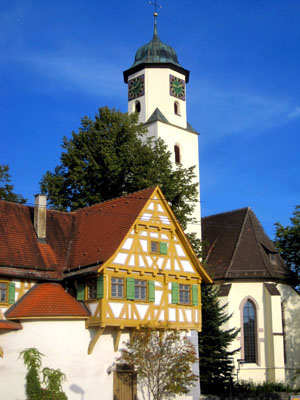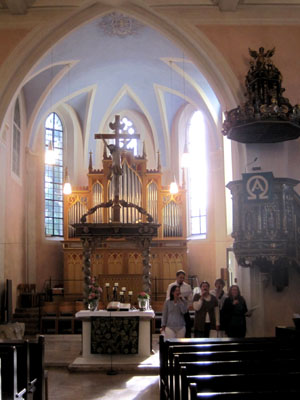| |
 |
 |
 |
| Comment on this report, or find other reports. |
 |
| Our Mystery Worshippers are volunteers who warm church pews for us around the world. If you'd like to become a Mystery Worshipper, start here. |
 |
| Find out how to reproduce this report in your church magazine or website. |
|
|
| 2244: St Alban's,
Laichingen, Germany |
 |
 |
 |
Mystery
Worshipper: Portola.
The church:
St
Alban's, Laichingen, Germany.
Denomination:
Evangelical-Lutheran
Church in Württemberg (Evangelische
Landeskirche in Württemberg).
The building:
The present church was built in the 14th century in High Gothic
style. In the course of the next seven centuries there were
several additions, changes and renovations: a balcony was added
in 1593; the pulpit was built 1662/63. In 1850/52 the church
was transformed into a so-called "classical sermon hall"
style and a "Romantic" organ was put in at that time.
Surrounding the church is a park-like setting, which is ideal
for after-service coffee on sunny days. There are plans in the
works to remove the uncomfortable pews and replace them with
flexible seating. Also, a kitchen, toilets, and two new rooms
are to be added. As is to be expected, there is some resistance
to the proposed changes, which – according to the newsletter
– is partially an honest exchange of opinions, but also can
take the form of ugly, anonymous rumours about the competency
of the ministers.
The church:
The origins of the Christian community at Laichingen go back
to 800. The Reformation reached Laichingen in 1536. The congregation
has two ministers, three kindergartens (with four groups of
children), a women's group, a youth group, a group for small
children called Fisherman's Friends, and at least one house
group. But there are probably groups and activities not listed
in the newsletter. The congregation strive to maintain a balance
between tradition and change that they hope will lead to stability
and growth. There seems to be an emphasis on instituting contemporary
worship and small groups. The newsletter rather boldly comes
down in favour of change: "Whoever wishes the Church to
remain the same," it states, "does not wish the Church
to remain."
The neighbourhood:
The church is framed by historic half-timbered houses, ancient
walls, and gates. This ensemble of structures is referred to
as the "church fortress." Laichingen is a small town
midway between Stuttgart and Augsburg, about 100 miles west
of Munich. It is in the middle of the Schwäbische Alb
(Swabian Highlands), a scenic high plateau in southern Germany
with picturesque valleys, castles, monasteries, and cosy towns
with half-timbered houses.
The cast:
Herr Pfarrer Albrecht Lächele, pastor; Herr Manuel Ritsch, theology
student. The names of the organist and the keyboard player were
not mentioned in the Kirchenzettel (information leaflet)
or in the newsletter.
The date & time:
11 September 2011, 9.30am.
What was the name of the service?
Worship Service with Baptisms.
How full was the building?
Well-filled. I could not judge the capacity, but there were
at least 100 in attendance. I could not see how many people
were sitting in the balcony. A contributing factor were the
three baptisms, which meant that three families with godparents
and guests were in attendance.
Did anyone welcome you
personally?
Pfarrer Lächele (which translates into English as Pastor Smiley)
greeted us personally with a handshake and engaged us in a short
conversation. Other people acknowledged our presence in a friendly
way with a "Guten Morgen" or a wave. Hymn
books and the Kirchenzettel (mentioned above) were
not handed out, but it was assumed that participants would help
themselves.
Was your pew comfortable?
The pew was not comfortable, which is why the church council
wants to replace them. The space between the pews was designed
for the shorter people who lived centuries ago. I had to sit
crooked, with my knees pressing against the pew in front. On
the other hand, I didn't mind this inconvenience – it forced
me to sit with a proper posture and did not allow me to slouch,
as I tend to do.
How would you describe
the pre-service atmosphere?
Lively. The singing group was practicing as I came in; it was
pleasant to listen to their singing and the keyboard accompaniment.
There was energetic conversation, which got louder as more people
entered.
What were the exact opening words of the
service?
"We celebrate our worship service in the name of the Father,
and the Son, and the Holy Spirit."
What books did the congregation
use during the service?
Evangelisches Gesangbuch Ausgabe für die Evangelische Landeskirche
in Württemberg (Evangelical Hymnal Prepared for the
Evangelical-Lutheran Church in Württemberg). The words
of the songs were projected onto two screens, above which was
a portrait of Martin Luther. I'll have more to say in a moment
about the portrait.
What musical instruments
were played?
Organ and electric keyboard.
Did anything distract
you?
The organ prelude is supposed to provide an opportunity for
quiet prayer at the beginning of the service. However, several
people not only continued to talk with one another during the
prelude, but they talked even louder than before, because they
were competing with the organ. During the sermon the pastor
had to stand up and admonish the confirmands to pay attention;
apparently some of them were conversing or playing with their
cell phones.

Was the worship stiff-upper-lip,
happy clappy, or what?
From what I had heard about the church in Württemberg,
I was expecting a sober, straight-laced style of service. Instead,
I encountered a refreshing liveliness. Some of the songs were
traditional Lutheran chorales, accompanied by the organ, but
the majority were contemporary praise songs, in which the congregation
were led by six singers. The congregation sang with animation
and even clapped their hands, but in typical German style they
remained seated during the singing. The distinct Swabian accent
of this region could be heard. There was humour, and there were
moments when love and care emerged – especially during the baptisms
or when the preacher was given a present.
Exactly how long was the sermon?
23 minutes.
On a scale of 1-10, how
good was the preacher?
6 – It was an honest exposition of the sermon text for
this Sunday: Isaiah 29:17–24 (in a little while shall come an
end to ignorance and injustice). Herr Manuel Ritsch used pauses,
personal experiences and change of tempo effectively. He had
a solid message to proclaim. His description of the mountains
of Lebanon (a theme within the sermon text) was striking. I
think that when he gains in experience, he will learn to speak
with more compactness and perhaps with more animation.
In a nutshell, what was
the sermon about?
Isaiah is a prophet who sees behind the façade and shakes
up the complacency of people, especially those who are self-satisfied
or who speak mockingly. He sees the hidden sufferings and injustices,
which society prefers to ignore. But he also sees a day coming
on which there will be liberation and healing that will encompass
all creation, a salvation that will include the dejected and
the disadvantaged. There are signs of this coming day that one
can see, not by looking at human achievement, but by focusing
on what God has done and is doing.
Which part of the service
was like being in heaven?
Toward the end of the service, a young man who had been confirmed
in this church several years ago explained how the house group
to which he belongs had come into being out of a desire to read
and discuss Biblical texts in a small group setting. This charming
moment – which revealed that the desire to read and discuss
the Bible is very much alive among young people – was like
a foretaste of heaven.
And which part was like
being in... er... the other place?
The newsletter described how the council and the clergy are
trying to deal with the cruel rumours and unfounded accusations
surrounding the renovation plans. As an outsider I cannot know
what is really happening – there are two sides to every
issue – but I do know church life intimately and it would
not be surprising to discover that something malignant is lurking
in the darkness of anonymity. A German proverb states: "Where
God builds a church, the devil builds a chapel next to it."
What happened when you
hung around after the service looking lost?
It was a mob scene, with lots of lively conversation in small
groups. The church was so full that no one would have noticed
me standing at the back. I hung around where the refreshments
were being offered, but no one spoke to me.
How would you describe
the after-service coffee?
The after-service coffee was prepared by a house group (the
one to which the young man who had spoken belongs). In addition
to coffee and tea, there were also mineral water (which was
my beverage of choice) and an assortment of fruit juices. There
were also cookies and home-made cake.
How would you feel about
making this church your regular (where 10 = ecstatic, 0 = terminal)?
8 – The church itself is strikingly beautiful. When I walked
in I was immediately immersed in a sacred atmosphere. This service
revealed that many good things are happening here, for which
the community can be grateful. It would be challenging to be
a part of this congregation, because they are focused on reaching
out to those who do not yet belong. They seem to have a clear
identity and to know what kind of Christian community they want
to be. I was impressed with the transparency of communication
between pastors, church council and congregation.
Did the service make you
feel glad to be a Christian?
Yes. It never ceases to amaze me that Christian faith is the
same in so many different places. At this service I encountered
the same spirit of Jesus and the same Christian faith that I
experience everywhere else, whether in Great Britain, the USA,
or eastern or western Germany.
What one thing will you remember about all this in seven days' time?
Earlier I mentioned the portrait of Martin Luther. Luther's
face in this painting is devoid of expression, as though he
wanted nothing to do with this service. On the one hand, he
would certainly have approved of using contemporary music to
glorify God, because this is what he did in the 16th century.
On the other hand, he was not oblivious to quality or lack thereof
in music. In this service, in which praise songs and Lutheran
chorales were sung side by side, it became apparent that some
contemporary music lacks the backbone of the strong chorale
melodies. But the congregation obviously enjoyed singing these
songs, so I think that Luther would have enjoyed the situation
even if he did look bored. |
|
|
 |
 |
 |
| We rely on voluntary donations to stay online. If you're a regular visitor to Ship of Fools, please consider supporting us. |
 |
 |
 |
| The Mystery Pilgrim |
 |
| One of our most seasoned reporters makes the Camino pilgrimage to Santiago de Compostela in Spain. Read here. |
 |
 |
 |
| London churches |
 |
| Read reports from 70 London churches, visited by a small army of Mystery Worshippers on one single Sunday. Read here. |
| |
|
|
|
|


